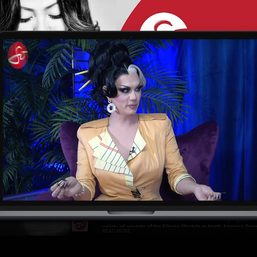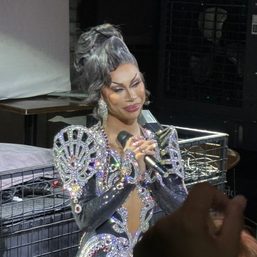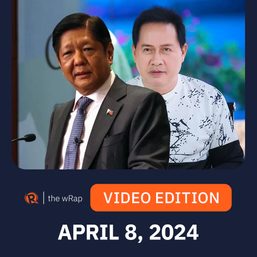SUMMARY
This is AI generated summarization, which may have errors. For context, always refer to the full article.

MANILA, Philippines – Queer talent, whether in mainstream media, art, culture, or otherwise, has always been present in the Philippines. But for a host of reasons, they often remain undeservedly obscure and unjustly underground. Much like the queer movement at large, queer artists have to carve out their own spaces not only to share stories of struggle, abundance, or complexity, but to surface their existence, their very personhood.
Such is the impetus behind this feature. Here, we spotlight four local queer artists, whose craft and creative signatures interrogate what we regard as art, excavate different realities, and create ways forward.
Gabriela She Lang, drag artist

Now that local drag culture is beginning to strut its way into the mainstream, propelled by a vibrant and committed audience, more, if not younger, artists are willing to take risks and take space.
Among them is Gabriela She Lang, who entered the local drag scene just a year ago and has since tried to elevate her drag in hopes of reaching a broader audience, much like the artists she holds in high regard have attained, such as Vice Ganda, Shea Couleé, and Marina Summers.
Donning a drag name forged after revolutionary leader Gabriela Silang, Gabriela, though still new to the art form, is already assured of her craft. “My kind of drag is very political,” she says. “I serve campy, militant, subversive art and also over-the-top fashion.”
She adds, “As a drag queen, I’ve always wanted to inspire other people with my story and share my vision and artistry in this art form. It gives me strength to provide social commentaries and reflect changing attitudes towards gender and performance. And that is why I think it is time to break the norms of the local drag scene – that behind the colorful performances, drag is also about our struggles as LGBTQIA+ people.”
“Here in the Philippines, we don’t have a law that protects the rights of not just the LGBTQIA+ community but the whole Filipino people from discrimination,” she notes.
Being an openly political drag artist, as Gabriela has come to learn, also means attracting increased aggression, especially at the height of the hostility towards Pura Luka Vega after appearing as Jesus Christ in drag and performing a rendition of Ama Namin at a Pride event last year, which gained the ire of right-wing evangelists and conservatives.
Gabriela was among those who protested the ridiculous charges against Pura. And despite this opposition, Gabriela remains resolute in her craft and the principles she holds.
“We receive death threats from trolls and anonymous accounts from social media. But we keep doing this and still continuing the fight for the rights of the marginalized sectors,” she says.
SUGARKISS, musician

Cebu-based artist SUGARKISS, a name inspired by the “sugar storm” scene in David Fincher’s Gone Girl, has been in the local music scene since 2017 and been writing songs as early as 2015.
Diane to her family and friends, SUGARKISS says music has always felt natural to her. “I do not know myself outside of music and there probably won’t be any me without it. It makes me emotional just thinking about how many times music has saved me in this lifetime,” she tells me.
But before plotting her own career and debuting as SUGARKISS this year, the 26-year-old artist first invested her creative energy in a band called Alice Who in 2019, releasing tracks such as “Oscar,” which she describes as “a diss on corrupt politicians,” and “Touch,” a queer anthem about the importance of consent.
As SUGARKISS, with work replete with heavy verses and hooks, as well as sweet, mellow bridges, she strives to “harness raw and unfiltered female rage, and highlight both the pain and catharsis of removing one’s self out of toxic situations.”
She says further, “I want to sing about self-reclamation and its power, and I hope my listeners share those feelings with me.”

Her debut single “Shatter Matter,” released in February, reflects such artistic preoccupations. “When you’re gone, I’ll learn to breathe in / Deep, so deep, I’m free to dive in / Down I freefall back into the water, I go now,” the song goes.
“It has been on the shelf since the pandemic, and I’m just glad that it’s out there for the world to hear,” shares the musician.
On June 28, SUGARKISS released new single “Leftover Love” in collaboration with producer Vince Lucero.
The artist also shares that, as a bisexual woman, she doesn’t feel confined whenever she centers queerness in her craft. “If anything, it excites me to know that people can have different takeaways when listening to my music, whether they relate to my queerness or other aspects of my identity.”
She adds, “Queer visibility gave me a sense of comfort and belongingness that was instrumental in my growth as an artist, and I believe that I share this feeling with other queer artists as well.”
When asked about the hurdles she encounters as an artist outside the Metro, SUGARKISS cites lack of venues as the glaring roadblock. “I’m forever thankful for alternative spaces that step up to the demand and offer their spaces for us to share our craft, as well as artist-run events that provide us platforms. I hope big establishments can show initiative as well,” she says.
Francis Jerimiah Manaog of ‘Picture lang,’ photographer

Armed only with a hand-me-down Nokia camera phone from his uncle, a migrant worker from Saudi at the time, Francis Jerimiah Manaog began taking photographs at age nine, and immediately became enamored with it, prompting him to enter campus journalism until high school through which he sharpened his artistic eye.
“What I enjoy most about photography is its possibility of permanence and how easy it is to tell stories through it,” he tells me. “Regardless, if you took deliberate time to take a photo, or [did it] randomly, it will always reflect your skill and preparation, your struggles and inclinations.”
A decade after his first foray into photography, Manaog entertained an idea that would later birth “Picture lang,” which doubles as an archive available via social media and project reflecting his visual lexicon, marked by its simplicity and accessibility.
Like the title warrants, which is “easy to remember and easy to say,” as the photographer puts it, Manaog’s images are ubiquitous, arresting, and at times silly but shaped tenderly through observation, among them: a photo of a cat, a dirty pillow atop a chair parked by the street, an anti-littering notice on a wall, and an umbrella hemmed in between two light posts.
But apart from Manaog’s penchant for the quotidian, what’s apparent in his work is how much of it is informed by grassroots realities, whether such realities be considered in the context of the fight against jeepney phaseout, historical revisionism, or the broader plight of the working class, which he documents as staff photographer for alternative press Mayday Multimedia.
He explains: “Most people who see my work say that I photograph the mundane but remain very relatable. That I take photos of things most people won’t notice, much less bother taking a photograph of. I agree that while that is the most apparent part of my work, I believe that my photos are relatable because they reflect the material conditions of life in our country.”
“It shows the objects and contradictions of a semi-colonial and semi-feudal country like ours. The dirt and grime of it, the lack of access to basic social services, the lack of access to food, the lack of jobs and national industrialization,” he adds.
Above anything, Manaog’s work counters the aesthetic default, which privileges images that are clear, pristine, and polished, an attitude of the neoliberal world interrogated by German filmmaker Hito Steyerl in her essay, In Defense of the Poor Image. Through “Picture lang,” in the way he exhibits the substandard or the out of focus, Manaog makes a compelling argument about access to information, culture as commodity, and the precarious conditions of the disenfranchised.
“Photography can be used to promote the struggles and aspirations of the people. It can be used to arouse and inform them towards organizing and mobilizing to fight for their rights. It is in the same league as painting, literature, music, film, and theater. The question is how we wield our art to serve the people,” he says.
Trixie Tierra, multidisciplinary artist

Hailing from Marikina, Trixie Tierra has long been making art, trite as it may sound, ever since she learned how to hold a pencil.
“Until now, I am still in awe of the most basic elements of art, the simplest materials one can use for creative expression, and the joy that learning brings,” she says.
She adds: “That is what I enjoy most about art, the lifelong process that goes into making it. Art evolves with every experience and interaction, constantly shaping and reshaping who we are. Beyond personal growth, art also holds the power to envision a better future for us all. And for many queer people, it is our source of collective hope and liberation.”
The 23-year-old Tierra, despite her venture into a range of artistic disciplines – from ceramic sculptures to embroidered statements, to crocheted typography, to graphite illustrations, and to book designs – isn’t some hobbyist. If anything, her work chiefly hinges on intention. “What do I intend to communicate and who is it for? Where do my materials come from and what meaning do they add to the work?”
For instance, in her textile work, most of which are available through “tahi tahi lang,” Tierra would rather use materials she already has, instead of shelling out money to buy new ones, exhibiting how her immediate environment molds the art she creates.
“That part of the process in itself already sparks inspiration as to what I could make with existing materials such as old clothing passed down from generation to generation and excess threads from previous projects,” she explains.

In 2021, the artist studied a new material: clay. “It became a form of meditation for me to focus on the process of creation rather than its physical outcome. There was a noticeable shift from using thick sculpting tools to thin needles, from heavy hands needed for molding to delicate hands required for sewing,” she says.
Through this close attention to her artistic process and her material’s very provenance, she has developed a broader philosophy. “Eventually, a perspective emerged on both clay and fabric as forgiving materials in the act of creation. They forgive us whenever we make mistakes in shaping, poking, pinching, cutting, or carving; and in the same way, we should have patience with ourselves. In each project, we are always given another chance to try.”
Above anything, Tierra asserts that her art is overtly political. “Having the firm belief in our capacity to use art in molding a more just and humane society, I always seek to collaborate with people’s organizations, human rights advocates, and communities who forward interwoven advocacies in their everyday lives,” she says.
In fact, at present, she serves as design consultant for Asia Pacific Forum on Women, Law and Development, and book designer for alternative publishing Gantala Press. In the past, she has done illustrations and publication design for IBON International.
Her favorite work bulay-bulay – “a collaborative performance using stoneware clay and domestic found objects” exploring the place of “working class women in molding society,” exhibited December last year – attends and attests to her political persuasions.
“Through bulay-bulay, we looked into domestic objects and acts of care to acknowledge and criticize these material conditions and prevailing inequalities. We hope to give gratitude to the domestic labor and care work that all the women in our lives have provided for us,” Tierra says.
Even her undergraduate thesis at the University of the Philippines Diliman centers on women laborers, particularly women vendors in Cubao, interrogating how they can confront their struggles through collaborative zine-making, through community art.
By drawing inspiration from her immediate surroundings and by allowing grassroots experiences to seep into her craft as she links arms with oppressed sectors, Tierra mines possibilities for art as an extension of care and of community, as a site of liberation. – Rappler.com
Add a comment
How does this make you feel?










![[IMHO] The other Pride march](https://www.rappler.com/tachyon/2024/06/IMHO-the-other-pride-march-june-20-2024.jpg?resize=257%2C257&crop=277px%2C0px%2C720px%2C720px)





There are no comments yet. Add your comment to start the conversation.